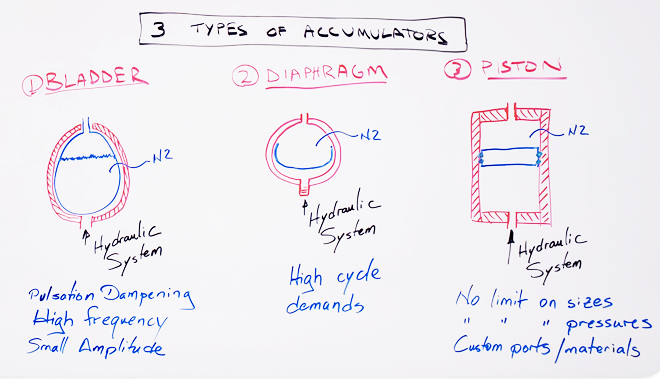Three Types of Accumulators

And here we come to the three different types of accumulators. We have the bladder, diaphragm, and the piston type of accumulators.
1. Bladder Accumulator
The Bladder is the bread-and-butter. You can use bladder accumulators everywhere. Most of the hydraulic systems use bladder accumulators.
- You have a bladder bag.
- You have the pre-charge of nitrogen.
- Connected to the hydraulic system.
Those accumulators are used in pulsation dampening where you have high frequency, especially in a small amplitude. A lot of applications, right? But this type of accumulator has a restriction. The bladder has a vulcanized seam, and this is the weak point of the bladder system. If you have high frequency and high cycle demand, you can have a rupture in this seam. This is the restriction of this type of accumulator.
2. Diaphragm Accumulator
Then we can go to the diaphragm type accumulator.
- Basically, the same where you have a carbon steel shell but instead of a bladder, you have a diaphragm.
- Also, the pre-charge of nitrogen and this portion is connected to the system.
Very similar applications as the bladder type accumulator. However, the diaphragm accumulator has an advantage.
Since you don’t have a seam in the diaphragm, you don’t have the restrictions that you have with the bladder type accumulator.
So applications pretty much the same, but this one is really a reliable accumulator, especially when you have high cycle demands. Applications with 1 million, 2 million, 3 million cycle demands – this is where to use a diaphragm accumulator.
3. Piston Accumulator
- Instead of a bladder or a diaphragm, we are using an aluminum piston to make a barrier with the nitrogen.
- You keep the nitrogen pre-charged.
- The system is connected to your hydraulic system.
But really you don’t have limits for this type of accumulator.
Since you machine the accumulator, you can make it in any size. You can make accumulators with a quarter gallon. You can make accumulators with 300 gallons. You can make accumulators going to 40,000 PSI.
Custom ports, custom design, and materials so the piston accumulator is really for limited applications where you can make custom design accumulators.
Thank you.